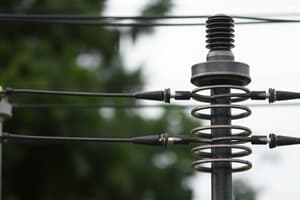Podcast
Questions and Answers
What is the primary function of a Molded Case Circuit Breaker?
What is the primary function of a Molded Case Circuit Breaker?
- To provide overcurrent protection and automatic disconnection of electrical circuits (correct)
- To increase the current rating of electrical circuits
- To provide overvoltage protection
- To regulate electrical circuits
What determines the maximum current that an MCCB can carry continuously?
What determines the maximum current that an MCCB can carry continuously?
- Current rating (correct)
- Number of poles
- Voltage rating
- Breaking capacity
What is the purpose of the thermal element in an MCCB?
What is the purpose of the thermal element in an MCCB?
- To increase the breaking capacity
- To respond to prolonged overcurrents (correct)
- To regulate the magnetic element
- To respond to short-circuit currents
What is the benefit of adjustable settings on some MCCBs?
What is the benefit of adjustable settings on some MCCBs?
What is the purpose of the tripping indicator on an MCCB?
What is the purpose of the tripping indicator on an MCCB?
What is the primary function of an ELCB?
What is the primary function of an ELCB?
What is the purpose of the arc chute in an MCCB?
What is the purpose of the arc chute in an MCCB?
What is the main difference between a V-ELCB and a C-ELCB?
What is the main difference between a V-ELCB and a C-ELCB?
What is the purpose of the test button on an ELCB?
What is the purpose of the test button on an ELCB?
What is the benefit of short-time delay and instantaneous tripping settings in an MCCB?
What is the benefit of short-time delay and instantaneous tripping settings in an MCCB?
What is the primary purpose of arc suppression in contactors?
What is the primary purpose of arc suppression in contactors?
What is the main difference between a contactor and an isolator?
What is the main difference between a contactor and an isolator?
What is the purpose of the mechanical interlock in some contactors?
What is the purpose of the mechanical interlock in some contactors?
What determines the power rating of a contactor?
What determines the power rating of a contactor?
What is the primary purpose of the operating mechanism in an isolator?
What is the primary purpose of the operating mechanism in an isolator?
What is the primary purpose of inverse time characteristics in protective devices?
What is the primary purpose of inverse time characteristics in protective devices?
What is the purpose of the threshold setting in inverse time characteristic curves?
What is the purpose of the threshold setting in inverse time characteristic curves?
What is the primary function of a contactor in an electrical circuit?
What is the primary function of a contactor in an electrical circuit?
What is the purpose of a single line diagram in electrical system analysis?
What is the purpose of a single line diagram in electrical system analysis?
What is the primary input to a contactor?
What is the primary input to a contactor?
What is the primary advantage of using a Motor Protection Circuit Breaker (MPCB) over a traditional circuit breaker?
What is the primary advantage of using a Motor Protection Circuit Breaker (MPCB) over a traditional circuit breaker?
What is the main purpose of phase failure protection in an MPCB?
What is the main purpose of phase failure protection in an MPCB?
What is the primary goal of electrical safety practices in industrial settings?
What is the primary goal of electrical safety practices in industrial settings?
What is the purpose of the manual reset feature in an MPCB?
What is the purpose of the manual reset feature in an MPCB?
What is the benefit of using compact Motor Protection Circuit Breakers (MPCBs) with DIN rail mounting?
What is the benefit of using compact Motor Protection Circuit Breakers (MPCBs) with DIN rail mounting?
What is the primary purpose of an earthing switch in an isolator?
What is the primary purpose of an earthing switch in an isolator?
Which type of relay uses semiconductor devices to perform the switching without moving parts?
Which type of relay uses semiconductor devices to perform the switching without moving parts?
What is the primary function of the coil in an electromechanical relay?
What is the primary function of the coil in an electromechanical relay?
What is the purpose of a latching relay?
What is the purpose of a latching relay?
What is the primary benefit of using isolators in electrical systems?
What is the primary benefit of using isolators in electrical systems?
What should you do when working on live circuits?
What should you do when working on live circuits?
What is the purpose of installing Residual Current Devices (RCDs)?
What is the purpose of installing Residual Current Devices (RCDs)?
What should you do if someone experiences an electric shock?
What should you do if someone experiences an electric shock?
Why is it crucial to maintain a safe distance from energized equipment and conductors?
Why is it crucial to maintain a safe distance from energized equipment and conductors?
What is the purpose of barricading and labeling hazardous electrical areas?
What is the purpose of barricading and labeling hazardous electrical areas?
Why is regular maintenance of electrical systems crucial?
Why is regular maintenance of electrical systems crucial?
What is the primary goal of electrical safety protocols?
What is the primary goal of electrical safety protocols?
Why is it essential to ensure personnel working with electrical equipment are properly trained and qualified?
Why is it essential to ensure personnel working with electrical equipment are properly trained and qualified?
What should you do if you notice any electrical issues or malfunctions?
What should you do if you notice any electrical issues or malfunctions?
Why is it crucial to provide first aid training to personnel, especially those working with electrical systems?
Why is it crucial to provide first aid training to personnel, especially those working with electrical systems?
Flashcards are hidden until you start studying
Study Notes
Molded Case Circuit Breaker (MCCB)
- A type of circuit protection device designed to provide overcurrent protection and automatic disconnection of electrical circuits in the event of faults
- Commonly used in industrial, commercial, and distribution applications where higher current ratings are required
- Key features and components:
- Frame: outer housing that contains internal components and provides mechanical strength and protection
- Operating Mechanism: includes thermal and magnetic trips to respond to prolonged overcurrents and short-circuit currents
- Current Rating: available in a wide range of current ratings, indicating the maximum current that the breaker can carry continuously
- Breaking Capacity: represents the maximum fault current that the breaker can safely interrupt without causing damage
- Number of Poles: available in various pole configurations (single-pole, double-pole, three-pole, four-pole) depending on the application
- Voltage Rating: designed for specific voltage levels (e.g., 230V, 400V, 690V)
- Adjustable Settings: some MCCBs have adjustable settings for thermal and magnetic trip elements
- Tripping Indication: often feature a tripping indicator to provide a visible signal when the breaker has tripped
Earth Leakage Circuit Breaker (ELCB)
- A type of circuit breaker designed to detect and disconnect electrical circuits when a leakage current to earth is detected
- Primary purpose is to protect individuals and property from the risks of electric shock caused by faulty wiring, appliances, or insulation
- Two main types: Voltage-Operated ELCB (V-ELCB) and Current-Operated ELCB (C-ELCB)
- Key features and components:
- Sensitivity: designed to be sensitive to low levels of leakage current
- Rated Current: rated based on the maximum current they can handle and still provide effective protection
- Tripping Time: the time it takes for the ELCB to trip when a fault is detected
- Number of Poles: available in single-pole, double-pole, three-pole, or four-pole configurations
- Reset Mechanism: often have a reset mechanism to restore power once the fault is corrected
- Test Button: sometimes include a test button to simulate a fault and check the device's functionality
Inverse Time Characteristics
- Refers to the behavior of certain protective devices in response to overcurrent conditions
- Tripping or opening time of the device varies inversely with the magnitude of the overcurrent
- Key features:
- Inverse Relationship: as the current magnitude increases, the tripping time decreases
- Logarithmic Scale: inverse time characteristic curves are often plotted on a logarithmic scale
- Slope: indicates the degree of inverse relationship between current magnitude and tripping time
- Threshold Setting: the point on the curve where the tripping time begins to decrease
Single Line Diagram (SLD)
- A blueprint for electrical system analysis
- Allows for familiarization with the electrical distribution system layout and design
- Often used to prepare a critical response plan
Contactor
- An electrical relay designed to switch an electrical circuit on or off
- Typically used for controlling electric motors, lighting, heating elements, and other power loads
- Key features and components:
- Coil: electromagnet that generates a magnetic field when energized
- Contacts: conductive elements that make or break the electrical connection
- Poles: can have multiple poles (single-pole, double-pole, three-pole) representing separate conductive paths
- Arc Suppression: designed to suppress arcing when the contacts open or close
- Mechanical Interlock: prevents simultaneous closure of multiple poles
- Overload Protection: may be integrated with overload protection devices
Isolator
- An electrical device used to ensure that a circuit or equipment can be completely de-energized for maintenance, repair, or other operational purposes
- Key features and components:
- Main Contacts: conductive elements that make or break the electrical connection
- Blades or Poles: can have multiple blades or poles representing separate conductive paths
- Operating Mechanism: allows for manual opening and closing of the main contacts
- Visible Break: creates a clear physical gap between the main contacts when the isolator is open
- Enclosure: often housed in an enclosure for protection against environmental conditions
- Lockout/Tagout Provision: may include provisions for lockout/tagout procedures
Relays
- An electromechanical or solid-state device that functions as a switch, using an electrical signal to control the opening or closing of contacts
- Key features and components:
- Coil: primary winding that generates a magnetic field when energized
- Contacts: movable, conductive parts that make or break the electrical connection
- Poles: can have multiple poles (single-pole, double-pole, multipole) representing separate conductive paths
- Type of Relays: electromechanical relays (EMR) and solid-state relays (SSR)
- Operating Principle: uses an electromagnetic coil or semiconductor devices to perform the switching
- Relay Ratings: rated for specific voltage and current levels
- Applications: used in motor control, lighting control, heating and ventilation systems, and automation systems
Motor Protection Circuit Breaker (MPCB)
-
A specialized type of circuit breaker designed for the protection of electric motors against faults and overloads
-
Combines the features of a circuit breaker and motor protection devices
-
Key features and components:
- Circuit Breaker Functionality: incorporates standard circuit breaker functions
- Motor Protection Functions: includes built-in motor protection functions to safeguard the motor against faults and overloads
- Thermal Overload Protection: monitors the motor's current and trips to disconnect power in the event of an overload
- Short Circuit Protection: responds quickly to interrupt the current flow in the event of a short circuit
- Phase Failure Protection: includes protection against phase failure or phase imbalance
- Adjustable Settings: often have adjustable settings for overload and short circuit protection
- Manual Reset: often requires manual intervention to reset the MPCB and restore power to the motor### Motor Protection Circuit Breakers (MPCBs)
-
MPCBs include visual indicators to display the device's status, such as whether it is in the tripped or reset state.
-
Compact design integrates motor protection features within a single device, reducing the need for separate components and simplifying installation.
-
DIN rail mounting enables easy installation on DIN rails, making them suitable for use in motor control panels and industrial applications.
-
MPCBs are widely used in industrial settings where electric motors play a crucial role in various processes.
Electrical Safety Practices
- Electric shock occurs when the human body becomes part of an electrical circuit, allowing electric current to flow through it.
- Electric shocks can range from mild to severe, posing significant risks, including injury, burns, and even death.
Preventing Electric Shocks
- Turn off power before working on electrical equipment or circuits, and use lockout/tag out procedures to prevent accidental reenergization.
- Use personal protective equipment (PPE), including insulated gloves, safety glasses, and other protective gear, depending on the task and potential electrical hazards.
- Inspect tools and equipment regularly for damage or wear, and replace or repair damaged tools before use.
- Work in dry conditions, avoiding wet or damp conditions, and use dry, insulated tools.
- Maintain a safe distance from energized equipment and conductors, and be aware of electrical clearance requirements specified by safety standards.
Safe Working Practices
- Use insulated tools when working on live circuits to prevent direct contact with electrical conductors.
- Barricade and label hazardous areas, and use barricades to prevent unauthorized access.
- Ensure personnel working with electrical equipment are properly trained and qualified.
- Provide first aid training to personnel, especially those working with electrical systems.
- Establish and communicate emergency procedures for electrical incidents, and have readily accessible emergency contact information and equipment.
Safety Devices and Maintenance
- Install Residual Current Devices (RCDs) to quickly disconnect power in the event of a ground fault.
- Use safe ladder practices, including non-conductive ladders and maintaining a safe distance from overhead power lines.
- Report electrical issues, malfunctions, or abnormal conditions promptly.
- Conduct regular inspections and maintenance of electrical systems to identify and address potential hazards.
- Comply with local electrical codes, regulations, and industry standards to ensure compliance with safety requirements.
Additional Safety Measures
- Ensure proper grounding of electrical systems to prevent the buildup of stray currents and reduce the risk of electric shock.
- Implement arc flash protection measures, including appropriate clothing and equipment.
- In areas with a potential for explosive atmospheres, use equipment and wiring methods suitable for hazardous locations.
- Know how to respond to electric shock, including calling for help, not touching the victim, turning off power, providing first aid, and seeking medical attention.
Studying That Suits You
Use AI to generate personalized quizzes and flashcards to suit your learning preferences.





